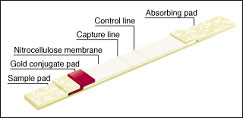{mosgoogle}
In clinical assays, the sample may be urine, blood, serum, saliva, or other body fluids. In nonclinical tests, the sample may be a small volume of solution prepared from soil, dust, plants, or food, and similarly applied directly to the membrane test strip. No instrumentation is required to perform such tests, which can be used in clinics, laboratories, field locations, and the home-often by inexperienced personnel.
1- Applications for rapid tests
Clinical applications

- Allergies
- Cardiac markers
- Degenerative diseases
- Drugs of abuse
- Fertility
- Forensic
- Immunotyping
- Infectious diseases
- Serological tests
- Sexually transmitted diseases
- Stress indicators
- Toxicology
- Tumor markers
Agricultural applications
- Food safety
- Plant and crop diseases
Environmental applications
- Biological contamination
- Environmental contamination
Veterinary applications
(Areas duplicate most human clinical applications)
2- Rapid test requirements
Membrane-based rapid tests are available for a wide range of clinical applications. Although most are used by healthcare professionals in clinical settings, an increasing number of tests are approved for use by relatively untrained home-users. To create rapid tests that will be successful in such a varied marketplace, manufacturers must be sensitive to the demands of both experienced and inexperienced test users. In addition, manufacturers impose their own set of requirements in order to gain the processing efficiencies needed to keep costs under control. Following are some of the key requirements for the current generation of rapid tests.
Ease of use. Perhaps more than any other feature, ease of use has made the category of rapid tests a viable commercial format. Generally speaking, such tests make use of versatile and uncomplicated biochemical technologies that require little or no experience to operate. User-oriented features that improve ease of use include single-step operation and a clear, easy-to-read test result.
Small sample volume. Tests that require only a small sample are strongly favored by clinicians and home-users alike. They have the advantages of requiring less user-experience in collecting a sample, generally faster performance, less potential for harming or causing pain to the patient, and reduced waste.
Speed. Rapid tests didn't get their name for nothing. In many clinical settings where such tests are used, speed is of the essence. According to clinicians, the ideal for such tests is to provide results within 3 minutes, and many rapid tests fulfill that requirement.
Flexibility. For many tests, time-to-result can be traded-off against the quality of the test results to match the needs of clinicians. For manufacturers, the ideal selection of materials for such tests would be those that could achieve qualitative, semiquantitative, or quantitative results without significant switching-out of substrates or reagents.
Clinical performance. To be useful in a wide variety of clinical settings, rapid tests must be able to achieve results comparable to those provided by instrumented testing in a clinical laboratory. Desirable characteristics of such tests include high sensitivity (<1% false negatives), high specificity (<1% false positives), and good long-term stability (12 months or more). When combined with good test design, the use of gold conjugates can help to reduce the incidence of false positives and false negatives while also increasing the long-term stability of a test. Gold conjugates with a stability guarantee of 12 months are commercially available.
Reliability. The evolution of rapid tests has resulted in a variety of dipstick or cassette-packaged formats that are rugged and suitable for use in environments ranging from emergency vehicles to home settings. But beyond the physical durability of such tests, they must also provide reliable results, with coefficients of variance in the range of 5% or less. When manufactured under stringent conditions, gold conjugates can help to enhance test reliability by minimizing batch-to-batch variations.
Low sales price. Rapid tests intended for use in clinical settings suffer from the same pricing pressure that has cut reimbursement rates for clinical laboratory testing across the board. Tests intended for home use suffer from price competition against similar products made by other manufacturers. In both cases, manufacturers are faced with a marketplace that demands an extremely low cost per result.
High added value. To make money on disposable rapid tests that are sold at a very low price, manufacturers must continually work to reduce their production costs. The ideal test would use readily available high-quality materials, would be easy to assemble in large quantities, and would have a low overall cost for materials and labor. In this equation, materials and reagents that are suitable for automated processing have a considerable advantage over those that require manual steps.